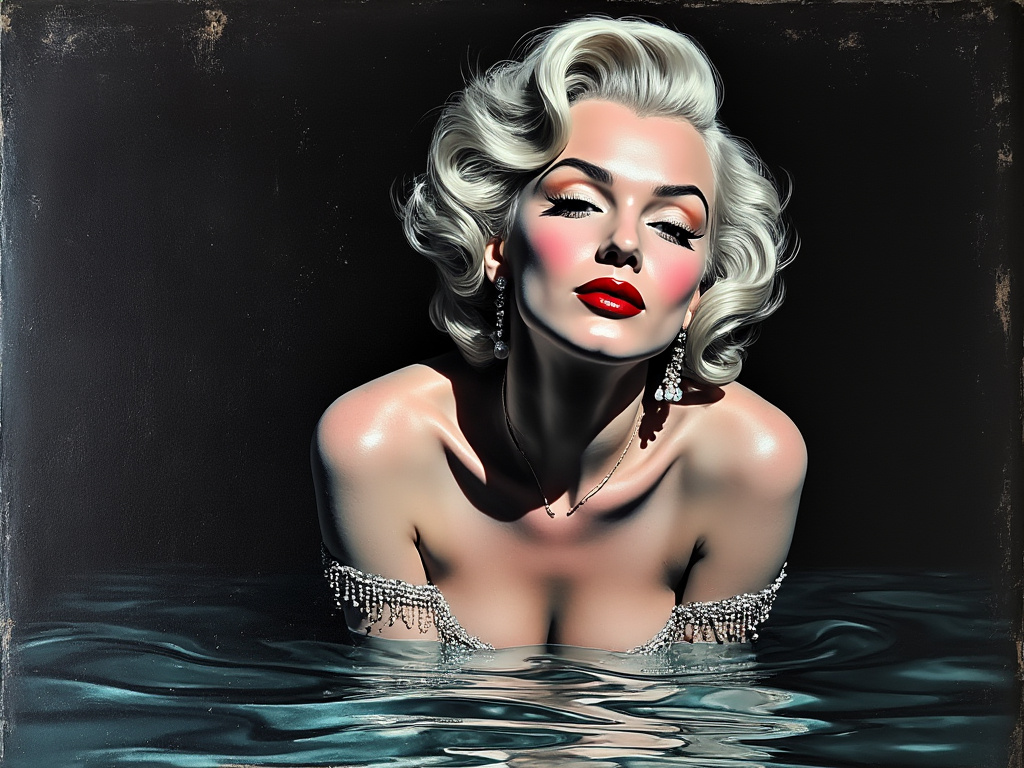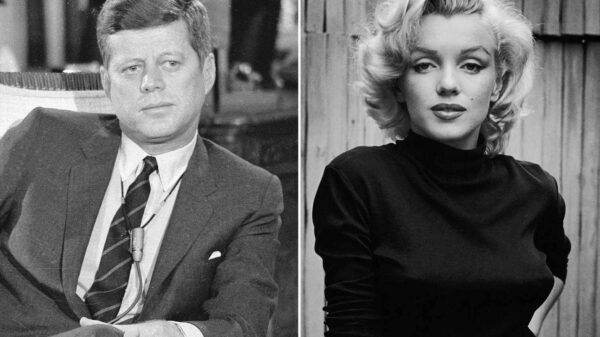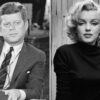Early Life (1926-1942)
Birth and Family Background
Born Norma Jeane Mortenson on June 1, 1926, in Los Angeles, California, Marilyn Monroe‘s origins were marked by uncertainty.
Two men claimed paternity on their deathbeds: C. Stanley Gifford, whom both Marilyn and her mother believed was her father but who refused to meet her, and Edward Mortensen, whose misspelled surname appears on her birth certificate.
This ambiguity about her parentage would haunt Monroe throughout her life.
Childhood Struggles and Foster Homes
Monroe’s early years were characterized by instability and displacement.
Following her mother’s inability to care for her, she was placed with eleven different sets of foster parents and spent nearly a year in the Children’s Aid Society Orphanage in Los Angeles.
These constant upheavals and lack of permanent family bonds deeply affected her emotional development and would influence her relationships throughout adulthood.
Mother’s Mental Illness and Impact
Gladys Pearl Baker, Monroe’s mother, struggled with severe mental health issues and was eventually institutionalized as a paranoid schizophrenic.
Mental illness ran in the family—Monroe’s maternal grandmother had died by suicide.
The specter of hereditary mental illness would become one of Monroe’s greatest fears.
When asked about her famous daughter, Gladys, who was hospitalized at Rockhaven sanitarium, reportedly stated, “I have never heard of Marilyn Monroe,” highlighting the profound disconnection between mother and daughter.
Early Influences and Dreams
Despite her challenging circumstances, young Norma Jeane found escape and inspiration at the movies.
“I didn’t like the world around me because it was kind of grim,” she later recalled.
“When I heard that this was acting, I said ‘that’s what I want to be.’” She was particularly fixated on Clark Gable, whom she dreamed might be her father—a fantasy sparked by a mysterious photograph her mother kept of a man with a thin mustache like Gable’s.
When Gable died years later, Monroe would cry for two days.
Transformation Years (1942-1949)
First Marriage to James Dougherty
At just sixteen years old, Monroe married James Dougherty, her first husband.
The marriage was largely one of convenience, arranged to prevent Monroe from returning to the orphanage when her foster family planned to move out of state.
Dougherty, who later became a detective in the LAPD, was eventually forbidden by his second wife from watching any of Monroe’s films.
Discovery at Radioplane Factory
In a twist of fate that would change her life, Monroe was working at the Radioplane munitions factory during World War II when photographer David Conover discovered her.
Sent by Ronald Reagan to shoot morale-boosting photos of female workers, Conover was immediately struck by Monroe’s photogenic qualities.
He photographed her during her lunch break, setting in motion the series of events that would transform her from factory worker to global icon.
Early Modeling Career
Following Conover’s advice, Monroe left her factory job to pursue modeling with the Blue Book Modeling Agency.
She quickly gained attention for her natural camera presence and willingness to work hard.
During this period, she modeled under various names including Jean Norman and Mona Monroe, taking risqué pin-up photos that would later make her hugely popular with soldiers in Korea.
Transformation into Marilyn Monroe
The creation of “Marilyn Monroe” was a deliberate and calculated transformation.
She went through several name changes before settling on her iconic moniker, which she legally adopted in March 1956.
The transformation wasn’t just nominal—she underwent several physical changes, including plastic surgery (a tip rhinoplasty and chin implant) paid for by her agent Johnny Hyde in 1950.
She also began the process of becoming the blonde bombshell, regularly bleaching her naturally brown hair every six weeks to maintain her signature platinum color.
Rise to Stardom (1950-1955)
Breakthrough Roles
Monroe’s path to stardom wasn’t immediate.
She cycled through multiple movie studios and saw film contracts expire.
However, her determination never wavered—she once told a friend, “If one hundred percent of the movie big shots in Hollywood told me I couldn’t make it to the top, I wouldn’t believe them.”
Her dedication to improvement was evident in her preparation for roles: she performed in a burlesque show under the name “Mona Monroe” to prepare for “Ladies of the Chorus” (1948) and observed workers in a cannery for “Clash by Night” (1952).
Creation of the “Blonde Bombshell” Image
The creation of Monroe’s signature image involved careful attention to detail.
She developed her famous breathy voice as a technique to overcome her childhood stutter.
She maintained a meticulous beauty regimen, including the regular bleaching of her hair.
She even refused to remove the fine blonde down on her face, believing it gave her a soft glow on camera.
Physical Transformation and Style Evolution
Monroe’s physical transformation was comprehensive.
Beyond the hair and surgical procedures, she used hormone cream to whiten her skin (which had the side effect of encouraging the growth of facial hair).
She became known for her daring fashion choices and was often photographed wearing nothing under the black mink coat Joe DiMaggio had given her.
Early Publicity and Public Persona
By 1953, Monroe had become “The Most Advertised Girl in the World” according to the Advertising Association of the West.
She represented numerous brands, including American Airlines, Kyron Way Diet Pills, Pabst Beer, Tan-Tan Suntan Lotion, and Royal Triton Oil.
She also became Playboy’s first Sweetheart (later Playmate) of the Month in 1953, though she had been paid only $50 for the original photo shoot in 1949.
Marriage to Joe DiMaggio
Monroe’s marriage to baseball legend Joe DiMaggio in 1954 seemed like a fairy tale union of American icons.
However, the relationship was troubled from the start.
The marriage lasted only nine months, ending after DiMaggio’s fury over the famous scene in “The Seven Year Itch” where Monroe’s white dress billowed up as she stood over a subway grate.
Despite their divorce, DiMaggio remained devoted to Monroe—for twenty years after her death, he arranged to have roses sent to her crypt three times a week.
Korean War Performances
In February 1954, Monroe interrupted her honeymoon with DiMaggio to perform for American troops in Korea.
Despite freezing temperatures that led to her developing pneumonia, she performed ten shows in four days, wearing a sparkling purple dress that delighted the soldiers.
Monroe later recalled this experience as “the best thing that ever happened to me. I never felt like a star before in my heart.”
Peak Years (1956-1959): The Evolution of an Icon
The mid-to-late 1950s marked a pivotal transformation in Marilyn Monroe’s life and career.
This period saw her stepping into more serious artistic pursuits while navigating complex personal relationships and emerging as a savvy businesswoman and social advocate.
Marriage to Arthur Miller
In 1956, Monroe married playwright Arthur Miller, a union that represented her deepening intellectual pursuits.
Before the marriage, Monroe converted to Judaism, demonstrating her commitment to Miller’s faith—a spiritual choice she maintained even after their divorce.
The relationship wasn’t without its challenges; Monroe’s support of Miller during his testimony before the House Un-American Activities Committee showed her loyalty despite potential career risks.
Studio executives and her acting teacher Paula Strasberg warned that such support could destroy her career, but Monroe remained steadfast.
Pursuit of Serious Acting
During this period, Monroe intensified her dedication to craft, studying Method acting under Lee Strasberg at the prestigious Actors Studio in New York City.
She worked with Paula Strasberg, who served as her personal acting coach and dramaturge, reportedly earning $25,000 per film—as much as some featured actors.
This commitment to improvement reflected Monroe’s determination to be taken seriously as an actress rather than just a “blonde bombshell.”
Business Ventures and Production Company
Monroe demonstrated her business acumen by forming Marilyn Monroe Productions with photographer Milton Greene in 1955, becoming only the second woman in Hollywood history to head her own production company, following Mary Pickford.
Her negotiation skills were evident when she secured the script for “The Prince and the Showgirl.”
She orchestrated a meeting with writer Terence Rattigan in New York, intercepting him en route to Hollywood and winning the script from under William Wyler’s nose.
Political Activism and Civil Rights
Contrary to her public image as merely a sex symbol, Monroe was deeply involved in political and social causes.
She attended rallies with Shelley Winters protesting civil liberties violations during the anti-Communist era.
Her progressive views on race led her to become an advocate for civil rights.
In 1960, she was elected as an alternate delegate to Connecticut’s state Democratic convention, though she didn’t attend.
Monroe’s support for civil rights was particularly evident in her advocacy for Ella Fitzgerald.
In 1955, when the color bar was still in force, Monroe convinced the management of a Los Angeles nightclub to book Fitzgerald by promising to sit in the front row for a week.
The Real Marilyn
Intellectual Pursuits and Love of Literature
Behind the glamorous facade lay a voracious reader and intellectual.
Monroe amassed a personal library of over 400 volumes, spanning classics, poetry, philosophy, and art.
At the time of her death, she was reading Harper Lee’s “To Kill a Mockingbird” and “Captain Newman MD.”
Her intellectual interests extended to Russian literature—when she met Soviet leader Nikita Khrushchev, they discussed “The Brothers Karamazov,” and she dreamed of playing Grushenka in a film adaptation.
Hidden Talents and Interests
Monroe was surprisingly athletic.
In her early years, she studied weightlifting with former Olympic champion Howard Corrington and went tandem surfing, balancing on her boyfriend Tommy Zahn’s shoulders.
She was also an early adopter of yoga, studying under Indra Devi, who taught other Hollywood stars like Greta Garbo and Gloria Swanson.
Personal Quirks and Habits
Known for her unique habits, Monroe often preferred to go naked, even during interviews and when working with female studio employees.
She was also known for her generosity, giving away valuable items like fur coats and regularly helping those in need, particularly children’s charities.
Relationships with Other Celebrities
Monroe maintained complex relationships with various celebrities.
She had a particular fixation on Clark Gable, her co-star in “The Misfits,” having dreamed as a young girl that he was her father.
When Gable died, she reportedly cried for two days.
Writers were particularly drawn to her—Jean-Paul Sartre wanted her to play a role in his film “Freud,” and Truman Capote considered her his first choice for Holly Golightly in “Breakfast at Tiffany’s.”
Final Years (1960-1962)
Professional Challenges
Monroe’s later career was marked by increasing difficulties.
During the filming of “Let’s Make Love,” her absences added 28 days to the shooting schedule and $1 million to the budget.
In 1962, she was fired by Twentieth-Century Fox from “Something’s Got to Give” due to chronic lateness and absences.
However, just days before her death, she was rehired on a $1 million, two-picture deal.
Personal Struggles
In 1961, Monroe faced one of her greatest personal challenges when she was institutionalized at New York’s Payne Whitney Clinic.
Desperate to escape, she broke a window and threatened self-harm.
It was her ex-husband Joe DiMaggio who came to her rescue, demanding her release and arranging her transfer to Columbia University Presbyterian Hospital.
Final Days
Monroe’s last months were marked by medical issues and increasing isolation.
Despite her struggles, she managed to deliver one of her most memorable performances, singing “Happy Birthday” to President Kennedy at Madison Square Garden in May 1962, wearing her famous skin-tight beaded dress that had to be sewn onto her body.
Legacy and Impact
Estate and Posthumous Earnings
Monroe’s estate continues to generate significant revenue, earning around five million dollars annually.
In 2011, Authentic Brand Groups purchased the licensing rights to her estate for approximately $30 million.
Her personal items have achieved astronomical values at auction—her white baby grand piano was purchased by Mariah Carey for $662,500, while her “Seven Year Itch” dress sold for £2.8 million.
Cultural Icon Status
Monroe’s influence on popular culture remains undiminished.
Her image continues to inspire artists, fashion designers, and performers.
Her estate carefully manages her legacy, with Anna Strasberg (who inherited 75% through Lee Strasberg) even vetoing the use of images where Monroe wears fur, citing the actress’s love of animals.
Philanthropic Legacy
The remaining 25% of Monroe’s estate was left to her psychiatrist, Dr.
Marianne Kris, who bequeathed it to England’s Anna Freud Centre, supporting children with mental health issues—a cause that would have resonated deeply with Monroe given her own childhood experiences.
Monroe’s legacy transcends her status as a sex symbol or movie star.
She emerges as a complex figure: an intellectual, activist, and businesswoman who challenged the constraints of her era while battling personal demons.
Her influence continues to resonate across generations, making her not just a legend of the past but a continuing source of fascination and inspiration.
Read more



